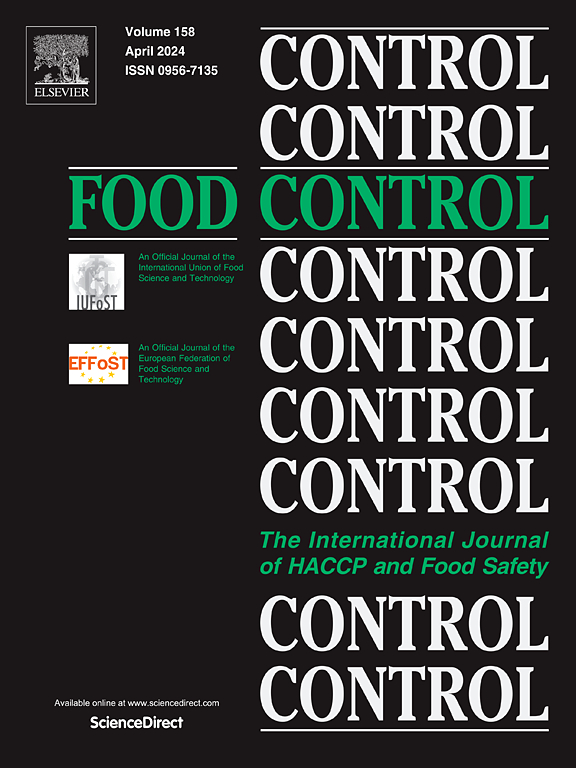基于靶向质谱法同时检测水产品中4种致病性弧菌的方法
IF 6.3
1区 农林科学
Q1 FOOD SCIENCE & TECHNOLOGY
引用次数: 0
摘要
致病性弧菌的广泛发生突出了对有效和准确的筛选技术的需求。在这项研究中,我们建立了一种新的基于靶向质谱(MS)的方法,可以快速同时检测水产品中的4种致病性弧菌——创伤弧菌、副溶血性弧菌、溶藻弧菌和霍乱弧菌。11个多肽被鉴定为弧菌生物标志物,可以准确区分这些细菌种类与其他传统食源性病原体。将靶向质谱法与浮力密度离心(BDC)相结合,有效地富集和分离了海产品基质中的弧菌,从而减少了复杂基质成分的干扰。对创伤弧菌、副溶血性弧菌、溶藻弧菌和霍乱弧菌的敏感性分别为81.8%、92.3%、87.5%和88.2%。该方法的检出限(LOD50)范围为0.462 ~ 1.15 CFU/25 g,是参考方法的1.15 ~ 1.33倍。由于所使用的肽生物标志物的高特异性,包容性和排他性精度均为100%。作为概念验证,将该方法用于商品水产品中4种致病性弧菌的筛选,检测结果与培养法一致。这些结果表明,通过提供可靠的检测策略,它有可能加强食品安全和公共卫生倡议。本文章由计算机程序翻译,如有差异,请以英文原文为准。

A targeted mass spectrometry-based method for the simultaneous detection of four pathogenic Vibrio species in aquatic products
The widespread occurrence of pathogenic Vibrios highlights the need for efficient and accurate screening techniques. In this study, we established a novel targeted mass spectrometry (MS)-based method that enables the rapid and simultaneous detection of four pathogenic Vibrio species—Vibrio vulnificus, Vibrio parahaemolyticus, Vibrio alginolyticus, and Vibrio cholerae—in aquatic products. Eleven peptides were identified as Vibrio biomarkers, allowing for accurate differentiation of these bacterial species from other conventional food-borne pathogens. By integrating the targeted MS method with buoyant density centrifugation (BDC), we efficiently enriched and separated Vibrio from seafood matrices, thereby reducing interference from complex matrix components. The sensitivity for V. vulnificus, V. parahaemolyticus, V. alginolyticus, and V. cholerae was 81.8 %, 92.3 %, 87.5 %, and 88.2 %, respectively. The level of detection (LOD50) for this newly developed method ranging from 0.462 to 1.15 CFU/25 g across all targets, which was 1.15–1.33 times higher than that of the reference method. Both inclusivity and exclusivity precision were 100 %, attributable to the high specificity of the peptide biomarkers used. As a proof-of-concept, this method was employed to screen commercial aquatic products for the four pathogenic Vibrio species, and the detection results were consistent with the culture method. These results demonstrate its potential to enhance food safety and public health initiatives by providing a reliable detection strategy.
求助全文
通过发布文献求助,成功后即可免费获取论文全文。
去求助
来源期刊

Food Control
工程技术-食品科技
CiteScore
12.20
自引率
6.70%
发文量
758
审稿时长
33 days
期刊介绍:
Food Control is an international journal that provides essential information for those involved in food safety and process control.
Food Control covers the below areas that relate to food process control or to food safety of human foods:
• Microbial food safety and antimicrobial systems
• Mycotoxins
• Hazard analysis, HACCP and food safety objectives
• Risk assessment, including microbial and chemical hazards
• Quality assurance
• Good manufacturing practices
• Food process systems design and control
• Food Packaging technology and materials in contact with foods
• Rapid methods of analysis and detection, including sensor technology
• Codes of practice, legislation and international harmonization
• Consumer issues
• Education, training and research needs.
The scope of Food Control is comprehensive and includes original research papers, authoritative reviews, short communications, comment articles that report on new developments in food control, and position papers.
 求助内容:
求助内容: 应助结果提醒方式:
应助结果提醒方式:


